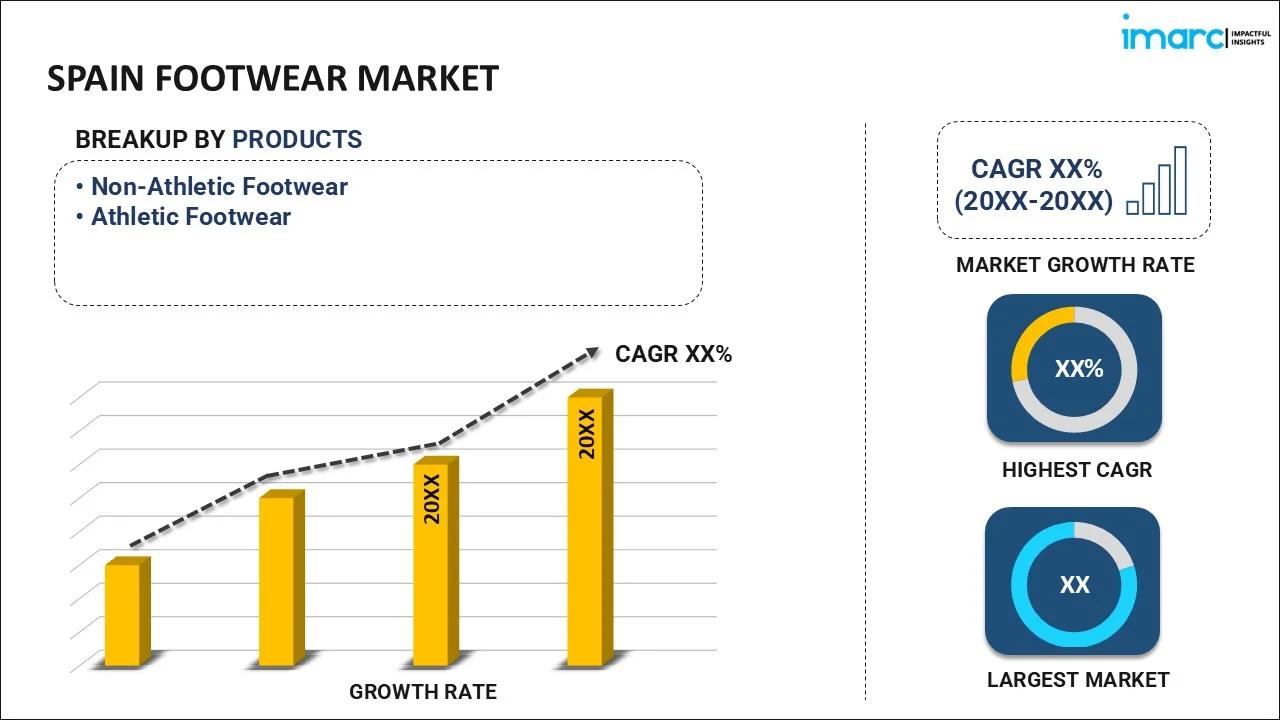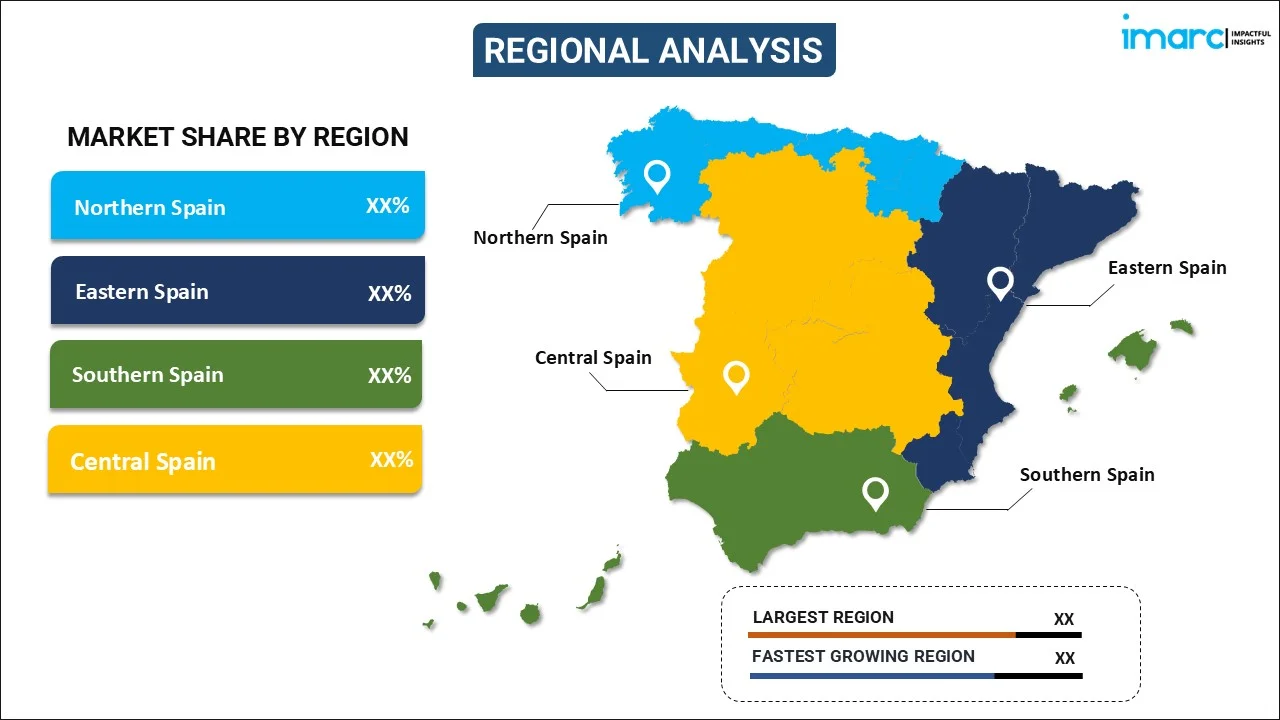
Spain Footwear Market Size, Share, Trends and Forecast by Product, Material, Distribution Channel, Pricing, End User, and Region, 2025-2033
Spain Footwear Market Overview:
The Spain footwear market size reached USD 4.05 Billion in 2024. Looking forward, IMARC Group expects the market to reach USD 5.55 Billion by 2033, exhibiting a growth rate (CAGR) of 3.60% during 2025-2033. The market enjoys diverse product offerings across sport and non-sport segments, based on leather, rubber, and fabric for men, women, and children, sold through footwear specialists, supermarkets, department stores, apparel stores, and websites, to serve both premium and mass-market customers.
|
Report Attribute
|
Key Statistics
|
|---|---|
|
Base Year
|
2024
|
|
Forecast Years
|
2025-2033
|
|
Historical Years
|
2019-2024
|
| Market Size in 2024 | USD 4.05 Billion |
| Market Forecast in 2033 | USD 5.55 Billion |
| Market Growth Rate (2025-2033) | 3.60% |
Spain Footwear Market Trends:
Rise of Sustainable Footwear
Sustainability is one of the most important drivers of Spain's footwear industry, and brands are paying more and more attention to eco-friendly materials like recycled rubber, organic cotton, and vegetable-based leather. Ethically produced products are something consumers are highly looking for, which has encouraged both premium and mass-market footwear companies to launch sustainable collections. For example, in May 2023, Spanish sustainable footwear brand Flabelus launched its SS23 collection at La Rubia NYC. Flabelus combines Spanish espadrille craftsmanship with Venetian Friulane aesthetics, emphasizing ethical production with recycled materials and traditional hand-stitched techniques. Moreover, footwear experts, supermarkets, hypermarkets, and online stores are contributing a great deal towards the availability of ecofriendly footwear at the mass market. Northern and Eastern Spain are becoming centers of sustainability, with companies developing biodegradable and cruelty-free products. Brands are also integrating circular economy practices, such as recycling services and repair clinics to increase the lifespan of their products. Ecofriendly footwear is becoming popular among men, women, and children alike. As ecological consciousness boots and regulations become more stringent, Spain's shoe manufacturing sector is poised to incorporate even more green principles, establishing new benchmarks in environmentally friendly production and distribution while staying fashionable and comfortable.
Growth of Online Footwear Sales
Spain's shoe market is evolving digitally, with e-commerce emerging as a leading distribution channel. Shoppers like the convenience of online shopping, creating an upsurge in direct-to-consumer fashion brands and digital-exclusive product lines. Hypermarkets, supermarkets, and department stores are strengthening their online presence to attract changing consumer habits. Digital platforms provide detailed information on products, enabling buyers to compare textures such as leather, fabric, and rubber prior to purchase. Northern and Central Spain are seeing especially robust online sales growth, with premium and mass-market footwear demand rising. Innovative technologies, including AI-powered recommendations, virtual try-ons, and customized shopping experiences, are enriching the digital retail experience. Social media marketing and influencer partnerships also fuel engagement, boosting brand visibility. While the habits of online shoppers keep changing, online sales of shoes are likely to dominate the marketplace, redesigning Spain's retail sector and directing future buying habits.
Increasing Popularity of Premium Footwear
Spain's footwear industry is witnessing amplifying demand for premium and high-quality footwear in men, women, and children's segment. Consumers are focusing on quality and craftsmanship and are shunning ordinary materials in favor of high-quality materials like prime leather and high-performance rubber. For instance, in July 2024, Spain’s Ecofap project, led by Aimplas, Pikolinos, Evatalking, and the Footwear Technology Centre of La Rioja, is advancing 3D-printed footwear materials using recycled leather to reduce industry waste and environmental impact. Additionally, premiumization is being witnessed across non-athletic and athletic segments, as top brands introduce special collections to address changing consumer aspirations. Department stores and footwear specialists are driving this trend, especially in Southern and Eastern Spain, with luxury and designer brands increasing their footprint. Online shopping has also been a factor in opening premium footwear to a wider base, with limited-edition products and customized advice becoming popular. Comfort, strength, and brand heritage are more important to Spanish customers when they buy footwear. As disposable incomes grow and fashion preferences change, demand for high-end footwear is likely to keep rising, cementing Spain's stature as a market leader for luxury shoes.
Spain Footwear Market Segmentation:
IMARC Group provides an analysis of the key trends in each segment of the market, along with forecasts at the region level for 2025-2033. Our report has categorized the market based on product, material, distribution channel, pricing, and end user.
Product Insights:

- Non-Athletic Footwear
- Athletic Footwear
The report has provided a detailed breakup and analysis of the market based on the product. This includes non-athletic footwear, and athletic footwear.
Material Insights:
- Rubber
- Leather
- Plastic
- Fabric
- Others
A detailed breakup and analysis of the market based on the material have also been provided in the report. This includes rubber, leather, plastic, fabric, others.
Distribution Channel Insights:
- Footwear Specialists
- Supermarkets and Hypermarkets
- Departmental Stores
- Clothing Stores
- Online Sales
- Others
The report has provided a detailed breakup and analysis of the market based on the distribution channel. This includes footwear specialists, supermarkets and hypermarkets, departmental stores, clothing stores, online sales, and others.
Pricing Insights:
- Premium
- Mass
The report has provided a detailed breakup and analysis of the market based on the pricing. This includes premium, and mass.
End User Insights:
- Men
- Women
- Kids
A detailed breakup and analysis of the market based on the end user have also been provided in the report. This includes men, women, and kids.
Regional Insights:

- Northern Spain
- Eastern Spain
- Southern Spain
- Central Spain
The report has also provided a comprehensive analysis of all the major regional markets, which include Northern, Eastern, Southern, and Central Spain.
Competitive Landscape:
The market research report has also provided a comprehensive analysis of the competitive landscape. Competitive analysis such as market structure, key player positioning, top winning strategies, competitive dashboard, and company evaluation quadrant has been covered in the report. Also, detailed profiles of all major companies have been provided.
Spain footwear Market News:
- In October 2024, Spanish sneaker brand HOFF launched its Fall-Winter 2024 collection, showcasing two new releases, MKII and Retrowave, as well as reloaded classics. Designed with a concept of city exploring and retro flair, the collection combines comfort and statement fashion. HOFF once again dominates the world sneaker trends through creativity and design.
- In February 2024, JOMA unveiled a limited edition of its R.2000 sneakers for the Movistar Madrid Medio Maratón. The shoe is intended for performance and recovery and has breathability, cushioning, and durability. Coming with a white upper and Madrid-inspired design elements, the shoe unites style with functionality for runners.
Spain Footwear Market Report Coverage:
| Report Features | Details |
|---|---|
| Base Year of the Analysis | 2024 |
| Historical Period | 2019-2024 |
| Forecast Period | 2025-2033 |
| Units | Billion USD |
| Scope of the Report | Exploration of Historical Trends and Market Outlook, Industry Catalysts and Challenges, Segment-Wise Historical and Future Market Assessment:
|
| Products Covered | Non-Athletic Footwear, Athletic Footwear |
| Materials Covered | Rubber, Leather, Plastic, Fabric, Others |
| Distribution Channels Covered | Footwear Specialists, Supermarkets and Hypermarkets, Departmental Stores, Clothing Stores, Online Sales, Others |
| Pricings Covered | Premium, Mass |
| End Users Covered | Men, Women, Kids |
| Regions Covered | Northern Spain, Eastern Spain, Southern Spain, Central Spain |
| Customization Scope | 10% Free Customization |
| Post-Sale Analyst Support | 10-12 Weeks |
| Delivery Format | PDF and Excel through Email (We can also provide the editable version of the report in PPT/Word format on special request) |
Key Questions Answered in This Report:
- How has the Spain footwear market performed so far and how will it perform in the coming years?
- What is the breakup of the Spain footwear market on the basis of product?
- What is the breakup of the Spain footwear market on the basis of material?
- What is the breakup of the Spain footwear market on the basis of distribution channel?
- What is the breakup of the Spain footwear market on the basis of pricing?
- What is the breakup of the Spain footwear market on the basis of end user?
- What is the breakup of the Spain footwear market on the basis of region?
- What are the various stages in the value chain of the Spain footwear market?
- What are the key driving factors and challenges in the Spain footwear?
- What is the structure of the Spain footwear market and who are the key players?
- What is the degree of competition in the Spain footwear market?
Key Benefits for Stakeholders:
- IMARC’s industry report offers a comprehensive quantitative analysis of various market segments, historical and current market trends, market forecasts, and dynamics of the Spain footwear market from 2019-2033.
- The research report provides the latest information on the market drivers, challenges, and opportunities in the Spain footwear market.
- Porter's five forces analysis assist stakeholders in assessing the impact of new entrants, competitive rivalry, supplier power, buyer power, and the threat of substitution. It helps stakeholders to analyze the level of competition within the Spain footwear industry and its attractiveness.
- Competitive landscape allows stakeholders to understand their competitive environment and provides an insight into the current positions of key players in the market.
Need more help?
- Speak to our experienced analysts for insights on the current market scenarios.
- Include additional segments and countries to customize the report as per your requirement.
- Gain an unparalleled competitive advantage in your domain by understanding how to utilize the report and positively impacting your operations and revenue.
- For further assistance, please connect with our analysts.
 Inquire Before Buying
Inquire Before Buying
 Speak to an Analyst
Speak to an Analyst
 Request Brochure
Request Brochure
 Request Customization
Request Customization




.webp)




.webp)












